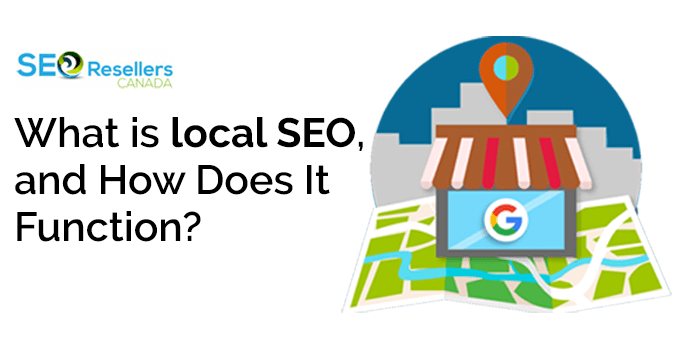Research has found that in the United States alone, there are an average of 12 billion web searches conducted every month, and most of these queries are done by the target audience. It doesn’t matter if you’re a B2B or B2C marketer or even an SEO expert because the good news is that 70% of the links that search users click on are organic search results. To truly sustain your rankings and search engine visibility you must respond to changes in search results by focusing on industry trends. After all, whenever Google releases an artificial intelligence search algorithm update, the face of the search engines tends to transform drastically. That can negatively impact your SEO campaign and your overall media marketing strategy.
You may not have actually seen these changes, but they’re interwoven into the way that search engines work and the way it produces search results. That’s the reason why you must approach search engines like an SEO expert, and always align your content and stay updated to your user’s needs, aligned with the then-current search algorithm.
When you continually do this, you will generate organic search traffic, but your personal brand will also take shape, and you won’t have any problems in attracting clients. The most traffic is generated through blogging and when you’re consistent, it will result in more search result traffic.
Contents
1- How Traffic Impacts SEO?
Can’t find your website in search results? You’re not going to be alone in that. There are millions of websites that struggle to carve out a space for themselves on search engines. If your current traffic numbers are on the lower side, you may be wondering if that’s hurting your chances of moving up the rankings. Although the total amount of traffic isn’t going to influence your search rankings, traffic does play a massive role in influencing where your website appears in search results.
It goes without saying that the more popular your website is, the better it is going to be. If you’re relying on people to find you through a Google search, then your search engine optimization (SEO) must be at the top of your priority list. You won’t be able to generate any leads for your business because no one can find you on search.
It is a fact that almost 93% of experiences on the internet all start with a search engine, but what happens after someone makes a search? The top result on Google gets a 33% chance of getting clicked but that means if you’re not number one on that page, you just missed out on a third of potential traffic. The astonishing part is that 75% of people won’t even click on the second page of the search results.
That’s the main reason why there are websites ranking higher than you on Google because they are making a conscious effort for improving their SEO rankings.
Using different tools in your SEO efforts can enhance your traffic but the question is, how does your traffic affect a website’s SERP rankings? Will their behavior signals come from visitors that have a ranking impact on a website?
We’ve done all the legwork for you and scoured through the ins and outs of website traffic to teach you all about how traffic impacts SEO.
1.1- Website Visits
Research studies have proven that website visits are an important indicator of the popularity of an online website, and technically the more visitors a website gets, the more popular it will become. There are several ways people can discover a website, and we highlighted some of them below:
- Emails
- Referring domains
- Social network
- Paid ads
- Organic search
- Direct traffic
These ranking factors and signals are the ones that will count the most for your website traffic.
1.2- Research Methods
With data coming from 600,000 search queries, our team calculated that the top three values for the top-100 positions in the SERP are as follows:
- Number of unique visits per month
- Number of visits excluding organic search traffic
- Number of visits per month
Then the team compared the total number of non-unique visits along with the total number of non-unique visits, except the ones that come from organic searches, to know if organic search visits are going to affect the final results.
As usual, to understand it better, the results were segmented into four keyword volume groups.
1.3- Unique Visits
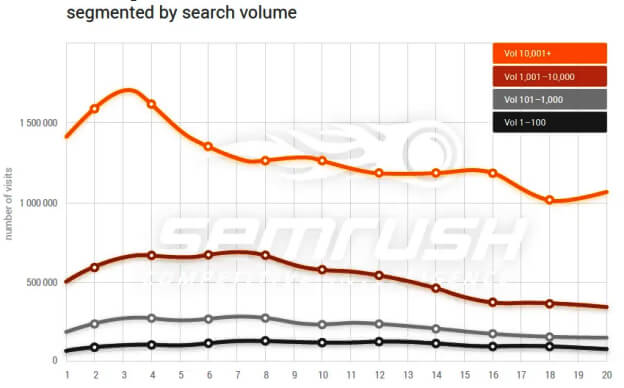
According to studies, pages that rank closer to the top of the SERP rankings are going to get more unique visits every month than those that rank lower.
Also, the domains that usually rank for low-volume keyword groups have fewer visitors compared to domains in high-volume groups.
1.4- All Visits
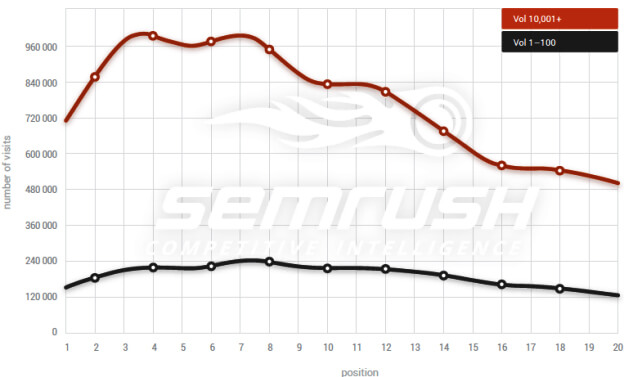
As per the graph, the flat trend in the low-volume keyword group indicates that a page’s ranking position won’t be directly related to its total number of visits. However, the small number of page visits for high-volume keywords becomes evident for websites that finish below 12th place.
1.5- All Visits Excluding Search Traffic
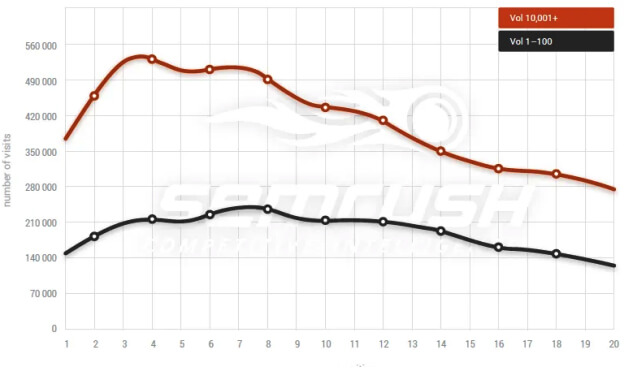
For the last part of the study, our team found that organic search has no effect on the final page rankings, and the trend curve for high-volume keyword groups will be more abrupt than the lower-volume keyword groups.
1.6- User Behavior Signals
As part of the research study, they also analyzed several user behavior signals like time on site, bounce rate, and pages per session that a user opens. These three signals are important to determine if:
- Users react positively to a website
- Website navigation is convenient for users
- Content of this website is engaging
Using the same number of queries our team calculated the median-value bounce rate, the amount of time that the user spends on the domain, and the number of pages that the user visits per session.
1.7- Bounce Rate
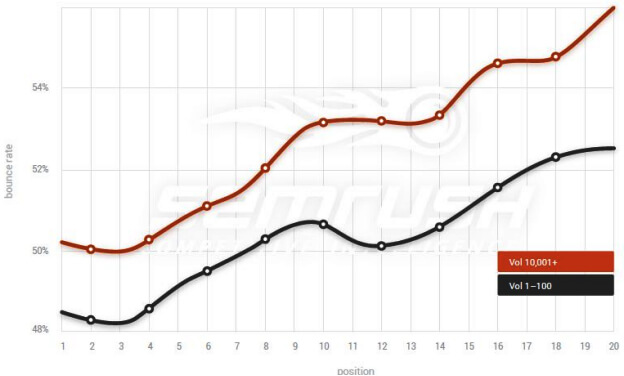
The graph above shows that the higher the position of the website, the lower it’s bounce rate is going to be. That means, people will be more engaged with high-authority websites than less popular ones in the lower ranks, and it also appears that high-volume keywords have a higher bounce rate of 49% where low-volume keywords have a 51% bounce rate.
1.8- Time on Website
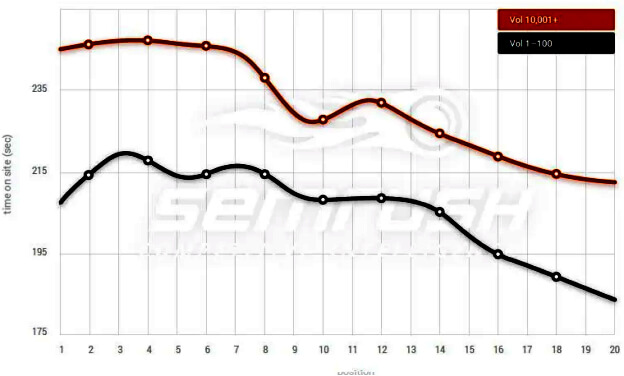
For the time on website behaviour signal, it’s evident that users must spend more time on high ranking websites because according to studies, users will spend an average of 40 seconds or less for low-volume keywords than for high-volume keywords.
1.9- Pages per Session
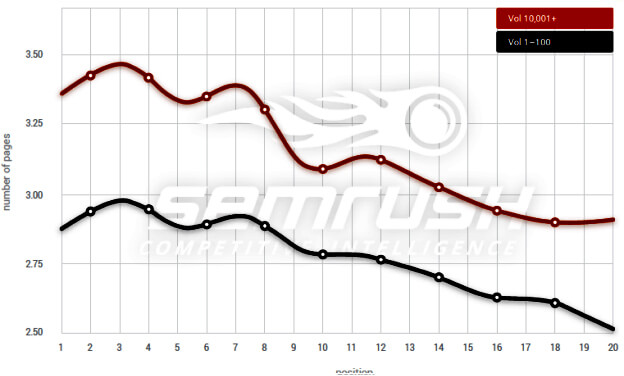
For the study on pages per session, our team found out that on average, the typical user navigates through three to three-and-a-half- pages per website, per visit. Apparently, as a website moves towards the top of the SERP ranking, it is going to receive more page visits per session.
1.10- Key Takeaways: The Way Traffic Affects Google Rankings
When you consider the results of the website visit study that we shared above, it clearly shows that the difference in page visits for the first ten positions and the following ones are more evident in high-volume keyword groups.
That can only mean that high authority domains must be prioritized by Google when you are ranking for high-volume keyword groups. The fact that organic search has no direct effect on the final page ranking only means that you should also focus on other strategies to gain traffic. When you keep that in mind, you can build a strong brand image that must always be a part of your SEO strategy.
2- Key Traffic Ranking Factors
A research study from SEMrush’s Ranking Factors, state that there are 17 key factors that you should be aware of when it comes to website ranking, which includes:
- Direct website visits
- Time on website
- Pages per session
- Bounce rate
- Total referring domains
- Total backlinks
- Total referring IPs
- Total follow backlinks
- Content length
- Website security (HTTPs)
- Total anchors
- Keyword in anchor
- Keyword in body
- Keyword density
- Keyword in title
- Keyword in meta
- Video on page
When you look at this list, it makes one thing clear, traffic is going to play a major role in the success of your website. However, Google is more focused on how users find your website and what they do on it than how much measurable traffic your website is getting.
Let’s unpack how the top-ranking factors affect your search engine optimization (SEO), and how you can take advantage of this knowledge to improve your rankings in search results.
2.1- Direct Traffic
If you’ve ever checked out your website’s analytics and checked where your traffic is coming from, you must have noticed that most users coming from the nebulous ‘direct traffic’. Traditionally, direct traffic is attributed to users manually when you enter your website’s URL into their web browser or by clicking on a bookmarked link.
Today, however, the story behind direct traffic is a bit more complex, and direct traffic can come from your employees who will type in the website URL. Customers who frequently visit your website, mobile traffic, people who have bookmarked your website, emails, unsecured HTTPs websites, links in apps or software.
Direct traffic is going to be the key to your ranking, and the SEMrush report states that even after you’ve added five new ranking factors to their report, the direct website traffic will be most influential. That’s when most users go to a website directly, as it signals to Google that the domain has high value and authority.
2.2- User Actions
Just simply earning more direct traffic won’t springboard your website to the promised land of the first-page search results. You do need quality traffic. Google will pay attention to factors that suggest your website will address the user’s search needs. Among the top-ranking factors that you need to land on your website are as follows:
2.2.1- Pages per Session
Pages per session include different pages that users look at when they are on your website, and Google looks at that because it is an indicator of engaging content, clearing website navigation and an obvious user path. The SEMrush report shows that as we move forwards to the top of the SERP, there will be more pages per session for every domain.
The number of pages per session is going to be the same on average, especially for the first four results. Time-on-site is the same because low pages per session show that your website isn’t only offering information to users who are looking for it, or at least not making the relevant information easier to find. That confuses website navigation, which may harm your pages per session.
2.2.2- Time on Site
The number two ranking factor, according to SEMrush’s research is how long the users are going to spend on your website once they land there. Are the users going to read your content or will they spend 30 seconds on your website and leave? Low time on the website shows to Google that your website isn’t fulfilling the needs of your users’ searches.
On the other hand, users who will spend a long time on the website will find what they were searching for and are spending time reading your content. You want to ensure that your website is optimized not only for high search volume keywords but also for relevant keywords. For instance, if the website is for a senior living facility, you don’t want it to be the top result for at-home care companies.
2.2.3- Bounce Rate
The bounce rate of your website is the number of users who are going to be leaving your website after they view a single page. These users bounce from every website but most of your users’ bounce, which is an indicator that something is off. According to SEMrush, nearly 50% of users is the average bounce rate of the domains ranking in the top three of search results.
Furthermore, the study concluded that the higher the position of a page, the lower it’s bounce rate. A higher bounce rate shows Google that the page has low relevance to searches, and if your bounce rate is high, you may need to consider the keywords you’re currently ranking for and ensure that they sync up with your offer.
To help your website improve each of these ranking factors, you must ensure that your website has engaging and relevant content that is easy to navigate and clear. When someone lands on your website, the path to solving their problem and becoming a customer should be a straightforward one.
3- Referral Traffic
Ranking factors five through eight will all relate to your website’s referral traffic and that traffic comes to your website through links on other websites. These could be to partner websites, articles, directories, or blog posts. SEMrush’s report confirms that all these factors influence each other directly, so your position is unlikely to change if you boost the values for one factor but ignore the others.
Here’s a breakdown of how Google will interpret your referral traffic:
3.1- Total Backlinks
Backlinks are links on other websites that drive to your website, and the difference between the referring domain and backlinks is that a referring domain may have multiple backlinks leading back to your website.
The research report from SEMrush uncovered that the more backlinks a domain has, the higher it’s position will be on the SERP. Similar to how referring IPs relate to referring domains, total follow backlinks will be connected to the total number of backlinks that the domain has and influences.
Follow backlinks refers to links that haven’t been marked ‘no follow’ by the link poster, and the links marked ‘no follow’ are going to lose their SEO advantage. Once again, building links to your website will not only increase your referral traffic but it is also going to increase your rankings in search results.
Out of the 17 main ranking factors, the top eight all relate to your website traffic. Even though you want to ensure your website is following the rest of the ranking factors noted in the SEMrush report, and you want to look at your current traffic and ensure that it’s healthy.
Are your users coming from the right sources? Do they appear to be engaged with the website? If you notice a high bounce rate without referral traffic, it’s worth reassessing your SEO strategy and ensure that you’re targeting the right kind of traffic. If you’re thinking that all this sounds like a lot of work, you’re not wrong because we have a guide that can help you diagnose any SEO problems that may be preventing your website from coming on top.
4- Ways You Can Improve More SEO Traffic
The good news is that there are numerous methods you can employ to increase your chances of getting ranked higher on Google searches. To get help with improving the traffic on your website, there are certain things that you can do to enhance your chances of ranking higher on Google searches. Here are the best ways you can do that:
4.1- Improve Your Page Loading Speed
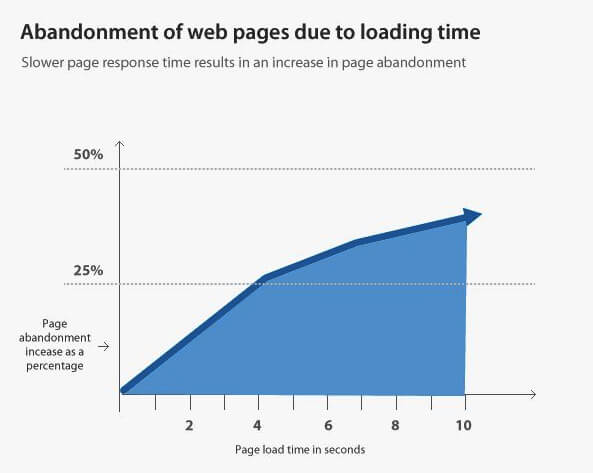
Your page loading speed is going to be very important for a couple of reasons. First of all, if your page speed is low, Google is going to recognize this, and it is going to harm your ranking. However, a slow website is also going to impact the way your website engages with visitors, and as a result, those negative interactions are going to hurt your rankings as well.
4.1.1- How slow is too slow?
Research has shown that 40% of all visitors will abandon websites if the page is going to take longer than 3 seconds to load. What’s even more shocking is that 80% of those visitors aren’t going to return to that website. That will have a terrible effect on your SEO ranking as it ultimately kills traffic to your website.
However, on the flip side, if the page loads fast, people are going to keep coming back. Google’s algorithm is going to recognize the popularity of your website and will adjust your search accordingly. That makes it very important to optimize both your server response time and page speed.
That will allow you to test your website from different locations all over the world, and if you find that your website is running slow, you may want to check the plugins and themes of your website.
4.2- Optimize Your Images
Images and pictures are great for your website, but you must ensure they are optimized properly if you want these images to improve your SEO ranking. I’m referring to factors like file format and size because huge images can slow down your page loading time and that will hurt your rankings.
You should compress or resize your images to sneak in keywords by naming them and you can strategically place keywords in the title of the image along with the description or caption.
4.3- Produce High-Quality Content
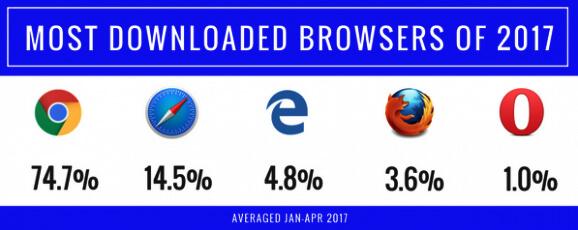
How often are you updating your website? If you haven’t touched it since the day you built it, you won’t have a great SEO ranking right now. To drive more traffic to your website and increase its popularity you must give visitors a reason to keep coming back. The content on your website must be recent, high-quality, and relevant.
Another factor that will impact your SEO rankings will be dwell time and that relates to how much time people spend on your website per visit. If your website is fresh, with newsworthy information, and exciting it is going to keep visitors on your page longer and also improve your dwell time.
Websites that offer highly informative content will generally have longer dwell times and you can save your content ideas in one place across all documents apps that you’ve used. Something else you should consider is that Google Chrome controls over 45% of the Internet browser market share, which makes it the most popular browser in the world.
That number is always going to increase, and when you bookmark your website from a Google Chrome browser, it will help with your SEO ranking. High-quality and relevant content is also going to increase the chances of your website being bookmarked by visitors.
4.4- Use Outbound Links
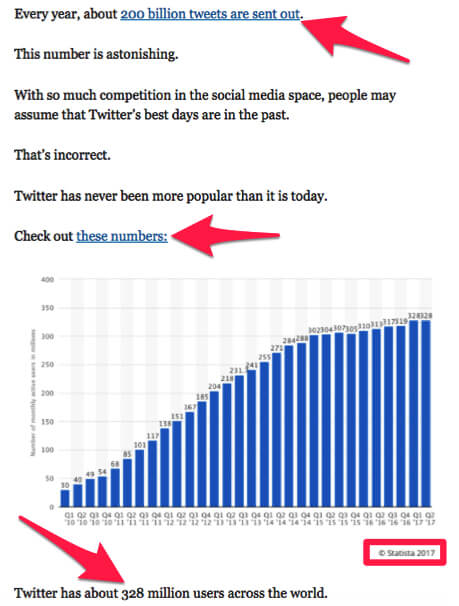
There are certain things you can do that will enhance the credibility of your website. You can make bold claims, but it will look better if you back those claims up. All your data claims must be linked to authoritative and trustworthy sources, like the example we have shared below:
You should also think about adding internal links as these links are going to direct visitors to other pages on your website.
4.5- Make Sure Your Website is Readable
Keep your audience in mind when you’re writing content on your website, and if you want people to visit your website and spend time there, you should speak in terms they can understand. Don’t try to sound like a doctor or a lawyer as your content should be written in a way that most people can easily understand what you’re talking about.
4.6- Properly Format Your Pages
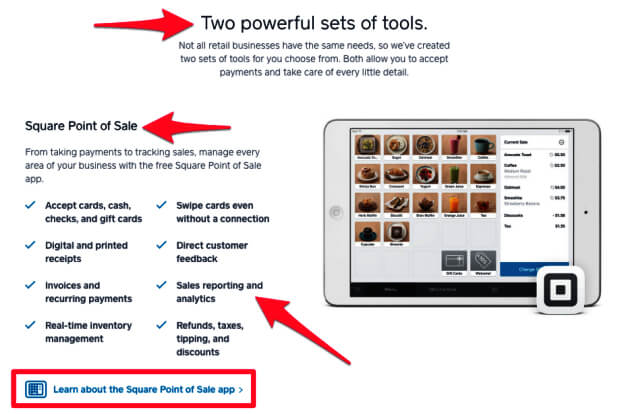
You can take your time when you’re coming up with a layout for your website. It needs to be clear, neat, organized, and uncluttered, while you should also consider things like typography and font size. You can use colored text, italics and bold fonts, with things like checklists and bullet points that make it easier for your visitors to scan through the content. An example is:
The layout is clean, and they’ve added a simple picture with a reasonable amount of text. The way the text is formatted makes it easier for people to read, especially if there are bullet points. If your website is cluttered with too many pictures, colors, advertisements, and blocks of texts it will appear untrustworthy. Your website architecture and navigation will fall into this category, as a clear format and design are going to improve your SEO ranking.
4.7- Use Keywords
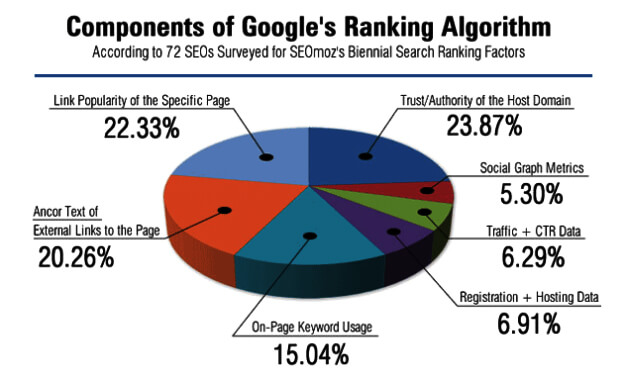
Check out some of the components of the Google Ranking Algorithm:
The main role played in this formula are keywords, and your goal should be to include words that people will be searching for throughout the content. However, you must do it sparingly and if you go overboard, you will saturate your website with keywords, and Google is going to pick up on this, and it will have an adverse effect on your rankings.
Keywords should fit naturally into sentences, and if you include them in your header tags, and even in image captions, you should be able to use long-tail keywords that are three- or four-word phrases that are found in a search.
For instance, someone probably won’t search for the word ‘phone’ when they’re looking for something, but they may type in the phrase ‘best phone for texting’ as an alternative. If your keyword matches their search, your website is going to have a greater chance of getting ranked higher.
4.8- Create a Mobile App
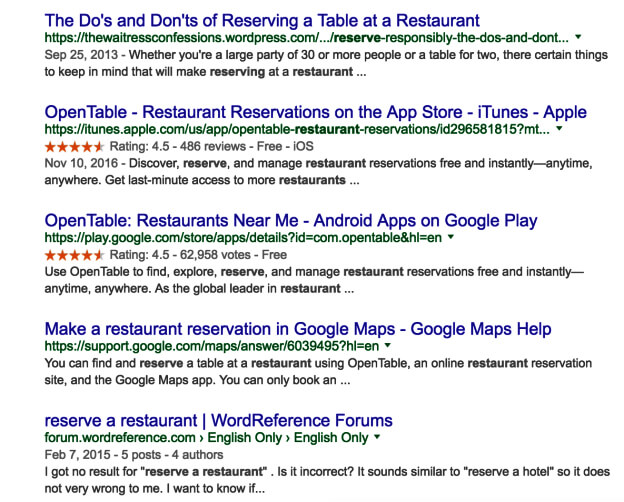
Creating a mobile app can be one of the best ways to boost your SEO, and even though it is an expensive option, it is also an investment. How exactly can an app boost your SEO? Google is now indexing apps on Google search, especially when people are searching for keywords in your niche, where they could find your app, which may create some juicy SEO.
For instance, when you search ‘reserve a restaurant’ on Google, you’ll find an app on the page:
When your app pops up on Google search, it will automatically become a valuable resource, and even though developing an app is going to be costly, it will provide you with some long-term benefits.
4.9- Use Infographics
No one can deny that infographics pack a huge SEO punch, but you want them to be powerful. To do that, you must do two things, focus on great design and great content. Most people tend to overlook the content when creating infographics and the result is that their infographics don’t perform well.
Another trick you can use when it comes to using infographics is to ensure that they are moving, as the data and the visualizations will keep the reader hooked.
5- Conclusion
Improving your organic website traffic and search rankings to the top is not going to happen overnight and you will need to put in the work. Inbound marketing does work for some people, and social media traffic had a big impact on others, especially when people started sharing them more aggressively.
There are several things to discuss here when it comes to SEO traffic and if you sit and listen to other’s opinions and analyze them you will get the hang of it. So, what do you think? Does referral traffic influence SEO rankings? Or can only one referring domain boost a website’s traffic and rankings from a lower position to the top position in a couple of hours?
Remember that the goal of SEO is to help a website rank in the SERP, but to do that, you must not only build stronger links with other reliable websites, get unique referring domains, minimize your website bounce rate, publish high-quality content with keywords, and ensure that you boost your website traffic by using the right tools and strategies.



















